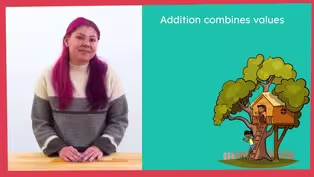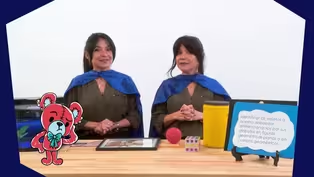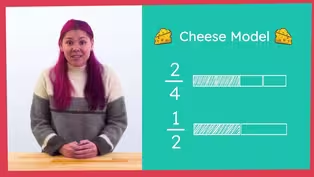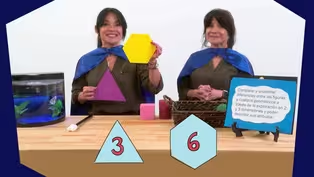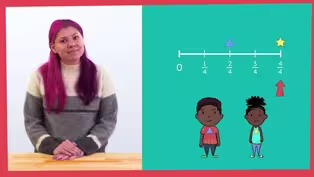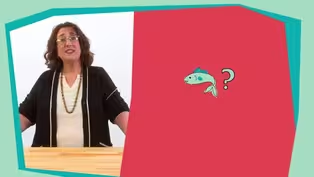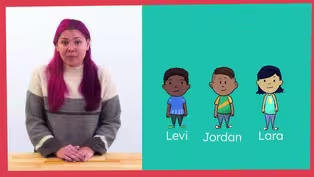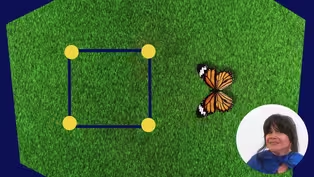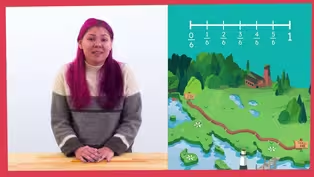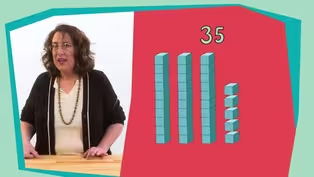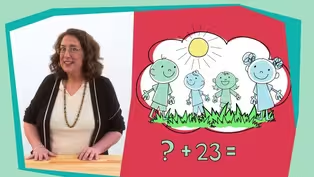
Episode 30 | Math Lessons
4/19/2021 | 28m 46sVideo has Closed Captions
Math lessons for early learners, led by NC teachers.
The first lesson (aimed at 3rd graders) helps students solve multi-step word problems. The second lesson (aimed at 1st-2nd graders) helps learners recognize and combine groups of numbers. Classroom Connection is your At-Home Learning companion where children love to learn. All lessons are led by NC educators.
Problems playing video? | Closed Captioning Feedback
Problems playing video? | Closed Captioning Feedback
At-Home Learning Presents: Classroom Connection is a local public television program presented by PBS NC

Episode 30 | Math Lessons
4/19/2021 | 28m 46sVideo has Closed Captions
The first lesson (aimed at 3rd graders) helps students solve multi-step word problems. The second lesson (aimed at 1st-2nd graders) helps learners recognize and combine groups of numbers. Classroom Connection is your At-Home Learning companion where children love to learn. All lessons are led by NC educators.
Problems playing video? | Closed Captioning Feedback
How to Watch At-Home Learning Presents: Classroom Connection
At-Home Learning Presents: Classroom Connection is available to stream on pbs.org and the free PBS App, available on iPhone, Apple TV, Android TV, Android smartphones, Amazon Fire TV, Amazon Fire Tablet, Roku, Samsung Smart TV, and Vizio.
Providing Support for PBS.org
Learn Moreabout PBS online sponsorshipMore from This Collection
Math lessons for early learners, led by NC teachers.
Video has Closed Captions
Math lessons for early learners, led by NC teachers. (28m 46s)
Video has Closed Captions
Math lessons for early learners, led by NC teachers. (28m 46s)
Video has Closed Captions
Math lessons for early learners, led by NC teachers. (28m 46s)
Video has Closed Captions
Math lessons for early learners, led by NC teachers. (28m 46s)
Video has Closed Captions
Math lessons for early learners, led by NC teachers. (28m 46s)
Video has Closed Captions
Math lessons for early learners, led by NC teachers. (28m 46s)
Video has Closed Captions
Math lessons for early learners, led by NC teachers. (28m 46s)
Video has Closed Captions
Math lessons for early learners, led by NC teachers. (28m 46s)
Video has Closed Captions
Math lessons for early learners, led by NC teachers. (28m 45s)
Video has Closed Captions
Math lessons for early learners, led by NC teachers. (28m 46s)
Video has Closed Captions
Math lessons for early learners, led by NC teachers. (28m 45s)
Video has Closed Captions
Math lessons for early learners, led by NC teachers. (28m 46s)
Providing Support for PBS.org
Learn Moreabout PBS online sponsorship[cheerful upbeat music] ♪ - Hi, friends.
Welcome to another awesome day of Classroom Connection.
I'm Mr. R, and I am so glad to see you today.
Did you know that this space right here, this space right here is magical?
Yeah, it's true.
And you know why?
Because this is where learning happens, and learning is the most magical thing ever.
I love learning new things.
Do you?
I know you do.
Today is going to be so much fun.
We're gonna learn about math as well as arts and science, but mostly we're gonna have some fun.
So let's jump in.
- Hello, third-grade friends.
Diane here.
I'm so glad to see you.
Today we're going to be solving multi-step problems using different strategies.
Before we get started, let's review what we know about the word strategies.
Let's use a Frayer Model to help us out.
Are you ready?
Let's get started.
To make our Frayer Model, you will need a piece of paper and a pen, a pencil, or a marker.
I'm going to go get my supplies.
You go ahead and do the same.
[gentle music] Now that we have our supplies, let's begin to make our Frayer Model.
Let's take a piece of paper and fold it in half hamburger style.
And then we're gonna fold it in half again to make four equal rectangles.
And then in the corner of our paper where all sides are folded, we're going to fold it down and make a small triangle.
[light music] When you unfold your paper, the folds should look like this.
Does yours look like mine?
Okay, great.
We're going to write the word strategies in the center diamond because this is the word we need to understand more about.
Then, in the upper left rectangle, we're also going to define this term.
So let's write the word definition here.
In the upper right rectangle, we're going to provide an example of a strategy.
So let's write example here.
Then, in the lower left rectangle, we'll provide a non-example or what strategies are not.
So, write non-example here.
And finally, in the lower right rectangle, we'll draw a picture to help us visualize what strategies are.
So let's write the word picture here to remind us of what we're supposed to do.
So now we're going to define the word strategy together.
So let's write the definition in our upper left rectangle.
A strategy is a method that can be used to solve a problem.
For example, if I wanna solve a problem involving addition and subtraction, I could use estimation, friendly numbers like tens and hundreds, or other strategies to help me think through the problem.
I'm going to give you some time to write this definition in your Frayer Model.
[gentle ambient music] As we use strategies to help us think through the math in today's lesson, you'll be able to add examples, non-examples, and draw a picture to share your growing understanding.
Let's move our Frayer Models to the side for now.
I could really use your help with a math problem that I'm having.
I'm planning a field trip to a local farm for all of the third graders in my school.
When we get there at 9:00 AM, they will load us onto shuttle vans that hold 10 riders.
How many vans should I reserve for all our students and their four teachers?
Here's the list of each class and the number of students in each class.
So Ms. Jones has 19 students, Mr. Garcia has 25 students, Ms. Hiatt has 23 students, and Mr. McNeill has 17 students.
Can you help me solve this problem?
Thank you.
The first thing I usually do when solving a problem is to try and make sense of what is happening and what I need to find out.
So let's go through some questions to better understand it.
What is happening in the problem?
Exactly, students are going on a field trip and have to be put into groups of 10.
Is there any extra information that we don't need?
Right.
We don't need to know what time they will arrive.
And what will the answer tell us?
Exactly, it will tell us how many vans we need to reserve.
So about how many vans do you think we will need?
Remember, this is an estimate, not an exact number.
Okay, I heard someone say nine because each class will have about two vans plus one more for the extras.
Great.
I think I understand the problem now.
Are you ready to help me solve it?
Wonderful.
What should we do first?
Okay, let's find the total number of students.
What equation could we use to find the number of students?
Yes, 19 + 25 + 23 + 17.
Now, how would you solve this?
I'll give you a few moments to think about this.
All right, can you tell me how you would solve it?
Oh wow, those are some great ideas.
Let me share a couple of the ones that I heard.
One idea I heard is to break apart or decompose the numbers and add by place value.
It would look like this: 10 + 20 + 20 + 10 = 60, and then 9 + 5 + 3 + 7 = 24, and then 60 + 24 equals 84.
Another idea I heard is to look for ways to add to get friendly numbers.
Remember, friendly numbers are multiples of 10 or 100.
They end in a zero and are easy to add.
I'm going to add 23 and 17 first because I noticed the 3 and the 7.
3 and 7 equals 10.
So 23 + 17 = 40.
Then I'm going to add 19 + 25.
19 is one more than 20.
So if I add 20 and 25, that would equal 45.
Then I would need to take away the one that I added to 19 so that would be 44.
40 + 44 = 84 students.
Okay, I feel confident that we have found the total number of students.
Are we finished solving our problem?
No.
So, let's read the problem again.
I'm planning a field trip to a local farm for all of the third graders in my school.
When we get there at 9:00 AM, they will load us onto shuttle vans that hold 10 riders.
How many vans should I reserve for all of our students and their four teachers?
Okay, I know there are 84 students.
Is there any other information that I need about the number of riders?
Oh, right!
I need to include the teachers.
So, 84 plus the four teachers would be 88.
So there are 88 total riders.
Now, what do we know about the vans?
Exactly, each van holds 10 riders.
So I need to put my riders into equal groups of 10.
What equation could we use for this problem?
Right.
We're putting a total number of objects or people into equal groups of 10.
This is a division problem.
We have 88 divided by 10.
How would you solve it?
I want you to try it out on your paper.
[gentle ambient music] Okay, how did you solve it?
For sure, we could count by tens.
10, 20, 30, 40, 50, 60, 70, 80.
How many times did we count to get to 80?
Eight times.
So 8 times 10 equals 80 with eight people left over.
So, will eight vans be enough for everyone?
No!
We'll need one more van for the other eight people.
Can't leave them behind.
So the answer to our question is nine.
We'll need nine vans to hold 88 people.
Is that a reasonable answer?
For sure.
Remember that our original estimate was nine vans.
So we matched our estimate.
Awesome job, mathematicians.
Thanks so much for helping me solve this problem.
I'm going to email the farm and reserve nine vans for our field trip.
Before we go, let's recap what we did today.
Our problem today was a multi-step problem.
It had two parts that we needed to solve.
Before we started solving, we made sure the problem made sense.
Then, we estimated our solution.
And then we started solving.
First, we added to get the total of students and teachers, and then we divided the total number of people into equal groups of 10.
Finally, we had to adjust our answer for the leftover number that wasn't enough for another group of 10.
You shared some great mathematical thinking today.
I wish you all could come on the field trip with me.
I'll be thinking about you and what amazing mathematicians you all are.
Until next time, bye.
- All this learning is making my brain grow.
Let's check out this next video that'll make your heart bigger too.
Music always makes my heart sing.
- My name is Colin Hartnett.
I'm a musician in the North Carolina Symphony, and today I'm gonna introduce you to my instrument, drum roll please!
[drums rumbling] The timpani.
[crowd cheering] Timpani is an Italian word.
Sometimes in English, we call them kettledrums.
Timpani are part of the percussion family, and in fact, they were the first percussion instruments added to the symphony orchestra way back in the 17th century.
I have two drums here at home but sometimes you'll see me playing four or more with the North Carolina Symphony.
They're big, shiny, and very heavy.
Each one of these drums weighs about as much as I do, which is close to 200 pounds.
What's special about timpani compared to most other drums is that they can produce a definite pitch, meaning I can play all different notes to match the other instruments in the orchestra.
If you look down here, I have pedals that I can use to change the pitch.
When I push the pedal down, [soft timpani music] the pitch goes higher because the drumhead gets tighter.
And when I let the pedal back, [soft timpani music] the drumhead loosens up and the pitch goes lower.
I can even play a musical scale just like any other instrument in the orchestra.
[soft timpani music] I started playing the drums in fourth grade.
Back then I wanted to play drum set so I could be in a rock band.
I first got to play the timpani in my school band, but I really fell in love with them in my college orchestra.
Even though I could play all types of percussion instruments, like the snare drum, the tambourines, cymbals, xylophone, those kinds of things, timpani are my favorite.
They're the only percussion used in a lot of the best symphonic music like Mozart, Beethoven, and Brahms.
One of my favorite things about playing timpani is I get to play the loud and exciting parts of music, like the end of Beethoven's 9th Symphony.
[loud timpani music] [dramatic orchestral music] But I can also play very quietly when I need to.
This music was written by Gustav Mahler as part of a funeral march.
[soft timpani music] You might've noticed that I used two different pairs of sticks or mallets for those two examples.
I have a lot of sticks because each different pair allows me to get a slightly different sound from the instruments.
I have sticks wrapped in a thick layer of felt that get a big, round sound.
[muffled timpani music] All the way to wooden sticks that are like regular drumsticks and sound very clear.
[clear timpani music] I even have some sticks for special effects, like this pair of sticks that's a cross between timpani sticks and maracas.
[sticks rattling] [loud timpani music] [sticks rattling] But most of the time, I play with something in the middle.
[slow timpani music] - Where y'all at?
Where y'all at?
Oh, there you are.
Yo, let's check out what we got next.
[chill music] - Hi, friends.
My name is Dawn.
This is Splat.
[robotic beeping] And we are so happy to be here with you today to work on fun math.
We are going to have some fun with subitizing.
Remember that subitizing is quickly seeing how many of an object such as dots.
I am so excited to do this with you today, and so is Splat.
We have a tool we are going to use to help us organize the dots we see today.
We are going to use a 10 frame to help us think about numbers that are 10 plus some more.
Sometimes we might even break apart numbers to make 10.
When we break apart numbers, that is called decomposing.
When we decompose numbers, we can use the smaller numbers to help us make a 10.
Then we can add on to 10 to find bigger sums or answers.
Your job today is to say how many dots you see with each picture that flashes on the screen.
Then you get to explain or show how you saw the dots to a friend or stuffed animal.
[cat meows] You can tell this to a trusted adult, stuffed animal, or even Splat.
[robotic beeping] Before we get started, can you go find a stuffed animal or adult to talk to during our subitizing?
You also might want to get some beans or pasta to show the different numbers you see on the screen.
And you might want to get paper and pencil or a notebook to write in, to explain what you learned today.
We'll wait for you to get everything.
[bright music] Welcome back!
I hope you found everything that you needed.
This is going to be so much fun.
Oh, I'm all ready!
Are you, Splat?
[robotic beeping] Okay, let's go!
Watch the screen!
That was super quick.
Tell an adult or even a stuffed animal how many dots you saw?
Yes, Splat and I saw 11 also!
How did you see those 11 dots?
Will you whisper to Splat how your brain saw those dots?
Splat said he saw one group of 10 dots and one dot left over and he knows that 1 + 10 = 11.
Did you say that too?
That's really great thinking.
What if I took away the one dot on the side?
How many dots would I have then?
Whisper to yourself how many dots I'd have if I took one away.
Oh, did you say 10?
That's right!
We know that 11 minus 1 equals 10 and our picture would look like this.
Great job thinking about the 10 frame.
I think we are ready for another one.
Are you ready?
Watch the screen.
Wow, Splat, did you see that?
It was super fast.
Friends, can you tell Splat how many dots you saw?
13?
That's right!
Great thinking!
Now, can you tell Splat how your brain saw those dots?
Friends, I want to share with you how Splat and I saw those group of dots.
I saw four dots on the side, and I took one dot and filled up the 10 frame to make it 10.
Then, I have three left over and I know that one 10 and three ones makes 13.
So I broke apart the four dots and used one dot to make a full 10 frame, then added the three dots I have leftover.
Are you ready to try some more?
Splat is!
Watch the screen for a new image.
Whoa, did you see that?
How many dots were there?
Tell an adult or stuffed animal how many dots there were.
Did you say that you saw 14 dots?
Splat agrees.
How did you know there were 14 dots?
Tell Splat how your brain figured that out, or make the dots with your beans or pasta.
[gentle guitar music] Splat said he tried to break apart or decompose the extra six dots and slid two of them into the 10 frame.
Then, he had four leftover and he knows that 10 and 4 makes 14.
Oh, that's right, Splat.
You could also see that there are eight dots in the 10 frame and six on the side, and know that 8 plus 6 equals 14.
There are so many ways to figure out how to make 14.
I have one more question about this 10 frame and dots.
What would I have if I took away a 10?
Think to yourself how many dots I'd have if we took away one whole 10.
Whisper to a friend or stuffed animal what your answer is.
That's right, we'd have four left if we took away a 10.
Tell Splat how you got your answer of four.
[gasps] I heard someone say that if we have one 10 and four ones, and we take away a 10, we are left with four ones.
That's correct.
14 minus 10 equals 4.
Okay, friends, Splat and I have time for one more image.
Are you ready?
Watch the screen.
Wow!
Splat was so surprised.
Did you see that?
There are two 10 frames.
Tell Splat how many dots you saw.
15!
Yes!
Great work.
Now tell Splat how you knew there were 15 dots.
Splat said he saw one group of 10 and one group of five, and he knows that 10 plus 5 equals 15.
Did you see that too?
But wait, I have one more question.
How many dots would we need to make 20?
I know that's a big number.
Whisper to yourself how many and how you would know.
Splat and I heard you say five.
That's right.
If we added five dots to the bottom row, we'd have two 10 frames full of dots, or 20 dots, because we know that 10 plus 10 equals 20.
That is great thinking about numbers and using your doubles facts to help you.
Splat and I have had so much fun here with you today.
We love subitizing with you and decomposing numbers.
When we subitize, we see things such as dots quickly.
When we decompose numbers, we break apart a number into smaller numbers.
We can use the smaller numbers to help us add on to make a new number.
Before we go, Splat and I would love to hear you say what you learned today in your own words.
I have these sentence starters and I'm hoping you can finish these sentences with me.
They say: Today in math, I learned... And I can...
So I might say, "Today in math, I learned how to subitize with numbers in 10 frames.
I can decompose numbers into smaller numbers and help me add on to find a total."
Now it's your turn.
Read this with me and finish it by telling an adult or stuffed animal.
[cat meows] Today in math, I learned... Great, now let's read our next sentence and you can finish it.
I can... What a great job you are doing talking about your math learning.
Next, you could also write this on paper or in your notebook and start a math journal.
Splat and I must go now, but you did a lot of hard thinking about numbers and how they combine to make new numbers.
You also did a great job of talking about your learning at the end.
Great work, and we hope we see you soon.
- Wow!
That was fun.
Sometimes I don't know if I'm gonna have fun learning, but then I always feel better when the lesson is over.
My brain is excited to keep on going.
Well, let's keep going then.
- This is not the first flying machine.
Humans have been strapping wings to their arms and jumping off cliffs and towers for centuries, and hot air balloons flew almost two centuries before the Wright Flyer.
However, what the Wright brothers invented was controlled, powered flight.
[gentle music] This plane can move in three different axes.
You can roll, you can yaw, and you can change the pitch.
By contract, a hot air balloon can only go up or down, and all you can do is try to find wind blowing in the right direction.
Otherwise, you're stuck in your basket.
Earlier heavier-than-air flying machines, steered only by the pilot shifting their weight, a technique which is finicky at best.
Imagine the pilot of a modern airliner, coming over the Intercom, [electronic tone] "We're now approaching Charlotte Douglas International Airport.
Please make sure your tray table is stowed and then lean to the right to line us up with the runway.
Thank you!"
[electronic tone] To steer the Wright Flyer to the right, Orville shifted his body in that wooden cradle, pulling wires connected to the wingtips, changing the shape to the wing and rolling the plane to the right.
Those wires also connect to this rudder, which rotates to steer the plane through the turn.
To change altitude, the pilot moved this handle, which angles the elevator to send the plane up or down.
The Wright brothers designed their own engines, off-center and balanced by the pilot's weight, and pioneered the use of propellers on aircraft.
Getting up in the air was one thing, but staying aloft with an engine and propellers, and then being able to steer and fly where you want is why we remember the Wright brothers as the inventors of powered flight.
- Well, it's time to go, but I can't wait to see you next time.
Hope you learned a lot today and everyday.
Wishing you peace, love, and lots of learning.
[cheerful upbeat music] ♪


- Home and How To

Hit the road in a classic car for a tour through Great Britain with two antiques experts.












Support for PBS provided by:
At-Home Learning Presents: Classroom Connection is a local public television program presented by PBS NC
